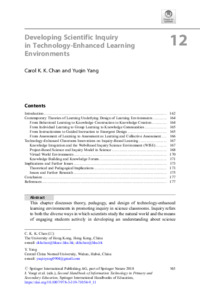Developing Scientific Inquiry in Technology-Enhanced Learning EnvironmentsCarol K. K. Chan, Yuqin Yang
Zu finden in: Second Handbook of Information Technology in Primary and Secondary Education (Seite 161 bis 180), 2018
  |
 |
 Diese Seite wurde seit 3 Jahren inhaltlich nicht mehr aktualisiert.
Unter Umständen ist sie nicht mehr aktuell.
Diese Seite wurde seit 3 Jahren inhaltlich nicht mehr aktualisiert.
Unter Umständen ist sie nicht mehr aktuell.
 Zusammenfassungen
Zusammenfassungen
 This chapter discusses theory, pedagogy, and design of technology-enhanced learning environments in promoting inquiry in science classrooms. Inquiry refers to both the diverse ways in which scientists study the natural world and the means of engaging students actively in developing an understanding about science content, science process, and how science develops. Supported by technology, students can be scaffolded to engage in inquiry practices, like those used by scientists, to help them deepen their understanding of science and to develop twenty-first-century educational competencies.
This chapter discusses theory, pedagogy, and design of technology-enhanced learning environments in promoting inquiry in science classrooms. Inquiry refers to both the diverse ways in which scientists study the natural world and the means of engaging students actively in developing an understanding about science content, science process, and how science develops. Supported by technology, students can be scaffolded to engage in inquiry practices, like those used by scientists, to help them deepen their understanding of science and to develop twenty-first-century educational competencies.This chapter employs the Learning Sciences research paradigm that emphasizes social-constructivist frameworks and design-based research methodology. We first outline changing theories and frameworks of learning, pedagogy, and assessment, and discuss how they influence the design of technology-based learning environments. We then examine several major research programs, including Knowledge Integration, Project-Based Science, Virtual Environments, and Knowledge Building, all of which focus on the alignment of technology, theory, and pedagogy, and emphasize iterative implementation and design principles. Analysis and comparison of these different programs help illuminate theoretical issues and educational implications and identify challenges to designing technology-enhanced inquiry-based environments. We conclude that theory, pedagogy, and technology need to be integrated, and design-based research can illuminate and support learner processes synergizing theory and practice in real-world classrooms.
 Dieses Kapitel erwähnt ...
Dieses Kapitel erwähnt ...
 Personen KB IB clear | Carl Bereiter , Carol K. K. Chan , Jennifer L. Chiu , Richard E. Clark , Lisa Dawley , Chris Dede , John Dunlosky , Arthur C. Graesser , Douglas J. Hacker , Freda Husic , Paul A. Kirschner , Jean Lave , Hee-Sun Lee , Marcia C. Linn , Marlene Scardamalia , Jim Slotta , Gerry Stahl , John Sweller , Robert Tinker , Etienne Wenger | |||||||||||||||||||||||||||||||||||||||||||||||||||||||||||||||||||||||||||||||||
 Begriffe KB IB clear | design-based researchdesign-based research | |||||||||||||||||||||||||||||||||||||||||||||||||||||||||||||||||||||||||||||||||
 Bücher |
| |||||||||||||||||||||||||||||||||||||||||||||||||||||||||||||||||||||||||||||||||
 Texte |
|
 Zitationsgraph
Zitationsgraph
 Zitationsgraph (Beta-Test mit vis.js)
Zitationsgraph (Beta-Test mit vis.js)
 Zeitleiste
Zeitleiste
 Anderswo finden
Anderswo finden
 Volltext dieses Dokuments
Volltext dieses Dokuments
 |  Developing Scientific Inquiry in Technology-Enhanced Learning Environments: Artikel als Volltext bei Springerlink ( Developing Scientific Inquiry in Technology-Enhanced Learning Environments: Artikel als Volltext bei Springerlink ( : :  , 303 kByte; , 303 kByte;  : :  ) ) |
 Anderswo suchen
Anderswo suchen 
 Beat und dieses Kapitel
Beat und dieses Kapitel
Beat hat Dieses Kapitel während seiner Zeit am Institut für Medien und Schule (IMS) ins Biblionetz aufgenommen. Beat besitzt kein physisches, aber ein digitales Exemplar. Eine digitale Version ist auf dem Internet verfügbar (s.o.). Es gibt bisher nur wenige Objekte im Biblionetz, die dieses Werk zitieren.



















 Biblionetz-History
Biblionetz-History